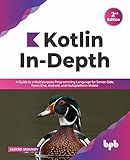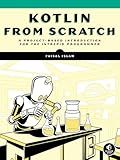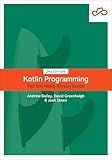Best Kotlin Adapter Development Resources to Buy in December 2025

Kotlin in Action, Second Edition



Kotlin In-Depth: A Guide to a Multipurpose Programming Language for Server-Side, Front-End, Android, and Multiplatform Mobile (English Edition)



How to Build Android Applications with Kotlin: A hands-on guide to developing, testing, and publishing production-grade Android 16 apps



Kotlin from Scratch: A Project-Based Introduction for the Intrepid Programmer



Kotlin Programming: Learning Guide Covering the Essentials and Advancing to Complex Concepts



Head First Kotlin: A Brain-Friendly Guide



Functional Programming in Kotlin



Kotlin Programming: The Big Nerd Ranch Guide


In Kotlin, creating a generic adapter involves creating a class that extends the RecyclerView.Adapter class and uses generics to accommodate different data types. Here's an overview of the steps involved:
- Import the necessary Kotlin and Android libraries:
import android.view.LayoutInflater import android.view.View import android.view.ViewGroup import androidx.recyclerview.widget.RecyclerView
- Create a generic class that extends RecyclerView.Adapter. The generic parameter will represent the type of data to be bound in the adapter. For example:
class GenericAdapter : RecyclerView.Adapter<GenericAdapter.ViewHolder>() { // ... }
- Inside the adapter class, define the ViewHolder class that extends RecyclerView.ViewHolder. This class will hold references to the individual views in the layout item for each list item. For example:
inner class ViewHolder(itemView: View) : RecyclerView.ViewHolder(itemView) { // ... }
- Implement the required methods of RecyclerView.Adapter within the generic adapter class. The main methods to override are: onCreateViewHolder: Inflates the layout for each list item and creates a ViewHolder object. onBindViewHolder: Binds data to the views within the ViewHolder object. getItemCount: Returns the total number of items in the data set.
Here's an example implementation for these methods:
class GenericAdapter : RecyclerView.Adapter<GenericAdapter.ViewHolder>() {
private var dataList: List<T> = emptyList()
// ViewHolder class
override fun onCreateViewHolder(parent: ViewGroup, viewType: Int): ViewHolder {
val itemView = LayoutInflater.from(parent.context).inflate(R.layout.item\_layout, parent, false)
return ViewHolder(itemView)
}
override fun onBindViewHolder(holder: ViewHolder, position: Int) {
val item = dataList\[position\]
// Bind data to the views in the ViewHolder
}
override fun getItemCount(): Int {
return dataList.size
}
// Optional: Method to update adapter data
fun updateData(data: List<T>) {
dataList = data
notifyDataSetChanged()
}
}
Note that you will need to replace R.layout.item_layout with the actual layout resource for your list items.
- After creating the adapter class, you can then use it in your RecyclerView by passing the appropriate data. You can set up the RecyclerView in your activity or fragment like this:
val recyclerView = findViewById(R.id.recyclerView) val adapter = GenericAdapter() recyclerView.adapter = adapter
Replace MyDataType with the type of data that you want to bind in the adapter.
How to use invariance in Kotlin generics?
Invariance in Kotlin generics means that you cannot directly substitute a class with its subtypes or supertypes. Here's how to use invariance in Kotlin generics:
- Declare a generic class or interface using the invariant keyword. For example, let's create a Box class that can hold any type of object:
class Box(val item: T)
- Use the generic class without any type variance. In this case, the Box class is invariant, meaning that you can only use the exact type specified when creating an instance of Box. For instance:
val box: Box = Box("Hello, World!") val message: String = box.item // No type mismatch error
- Attempting to assign an instance of a subtype will result in a type mismatch error. For example:
val box: Box = Box("Hello, World!") // Type mismatch
- The same applies when trying to assign an instance of a supertype:
val box: Box = Box("Hello, World!") // Type mismatch
By default, Kotlin's generic classes are invariant. However, you can use the out and in keywords to specify covariance and contravariance, respectively, if necessary.
What is function type generic parameter in Kotlin?
In Kotlin, a function type generic parameter refers to a generic type parameter that represents a function. It allows you to write code that is generic over functions with different parameter types or return types.
Function types are denoted by an arrow syntax ((T) -> R), where T represents the function's parameter type and R represents the return type. For example, () -> Unit is the type of a function that takes no arguments and returns nothing.
Function type generic parameters can be used to define generic classes, interfaces, or functions that work with different kinds of functions. They provide a way to specify that a generic parameter represents a function and define its parameter and return types.
Here is an example of a generic function processData that takes a function as a parameter:
fun <T, R> processData(data: T, processor: (T) -> R): R { // Process the data return processor(data) }
In this example, T represents the type of the data to be processed, and R represents the return type of the processing function. The processor parameter is of type (T) -> R, which means it can accept any function that takes a parameter of type T and returns a value of type R.
By using function type generic parameters, you can write more flexible code that is not tied to a specific function signature.
How to pass a generic parameter to a function in Kotlin?
In Kotlin, you can pass a generic parameter to a function by specifying the generic type when declaring the function. You can then use this generic type within the function body.
Here's an example:
fun printItem(item: T) { println(item) }
fun main() { val name = "John" val number = 10
printItem(name) // pass a String
printItem(number) // pass an Int
}
In the printItem function, <T> is used to specify a generic type. Within the function body, the item parameter is treated as an object of type T. When calling the function printItem, you can pass any type of object as an argument.
In the main function, we call the printItem function twice, once with a String and once with an Int. The function is able to handle both types because it is written to work with any type (T).
How to enforce type safety with generics in Kotlin?
In Kotlin, you can enforce type safety with generics by specifying the type parameter when defining a generic class or function. This ensures that only the specified type or its subtypes can be used as arguments or return types.
Here's how you can enforce type safety with generics in Kotlin:
- Define a generic class:
class Box(private val item: T) { fun getItem(): T { return item } }
In the above example, T is a type parameter that can be replaced with any type when creating an instance of the Box class. The getItem() function returns an item of type T.
- Create an instance of the generic class with a specific type:
val stringBox = Box("Hello") val intBox = Box(42)
In this example, the stringBox variable holds a Box instance that can store a String, and the intBox variable holds a Box instance that can store an Int.
- Use the generic class with the specified type:
val item: String = stringBox.getItem() val number: Int = intBox.getItem()
Here, the getItem() function returns a value of the specified type. If you try to assign the result to a different type, it will cause a compilation error.
- Specify type constraints with upper bounds: You can restrict the types that can be used as type arguments by specifying upper bounds. For example, if you want to enforce type safety for a generic class that only accepts types that implement a certain interface, you can define the class as follows:
interface Printable { fun print() }
class Box(private val item: T) { fun printItem() { item.print() } }
In this example, the Box class can only accept type arguments that implement the Printable interface.
By enforcing type safety with generics, you can catch type mismatches at compile-time, which helps in preventing runtime errors and makes your code more robust.
